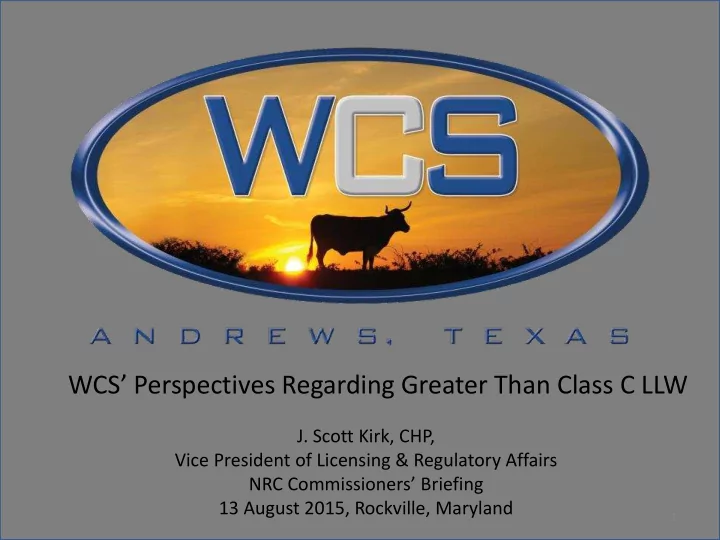

WCS’ Perspectives Regarding Greater Than Class C LLW J. Scott Kirk, CHP, Vice President of Licensing & Regulatory Affairs NRC Commissioners’ Briefing 13 August 2015, Rockville, Maryland 1
SECY-15-0094 • WCS commends the NRC, TCEQ , and DOE for making significant strides that could provide a pathway for the disposal of commercial and federally owned or generated GTCC LLW. • Allows for the disposal of waste based on the hazards posed to public health, via a Site-Specific Analysis. • Provides for a disposal pathway for orphaned disused sealed sources as specified in the Energy Policy Act of 2005. • Also provides a disposal pathway for other orphaned wastes needed to cleanup certain DOE sites. 2
Option 2 • WCS agrees with the NRC Staff that Option 2 is preferable. • It is consistent with historical NRC statements expressing a desire to retain the option of allowing Agreement States to regulate the disposal of GTCC LLW. • Texas has extensive knowledge of the WCS facilities that would lead to greater regulatory efficiencies. • Texas could request that the NRC approve a proposal to license the disposal of GTCC LLW pursuant to 10 CFR 61.55.(a)(2)(iv). • NRC regulatory oversight is provided through the Agreement State Integrated Materials Performance Evaluation Program. 3
Option 2 (Cont.) • Approach would establish clear cut Federal and State licensing pathways for disposal of GTCC LLW. • Avoids having to construct a new cell for the disposal of commercial GTCC LLW that would be licensed by the NRC. • A separate rulemaking is needed to ensure that waste containing certain alpha-emitting transuranic radionuclides at concentrations exceeding 100 nCi/g are not orphaned. • Consistent with a framework more closely aligned with ensuring disposal of waste is based on risk, as opposed to its origin and statutory definition. 4
Petition for Rulemaking • WCS submitted a Petition for Rulemaking that was unanimously approved by the TCEQ Commissioners on September 10, 2014. • Petition proposed changes to Texas regulations removing the prohibitions to dispose of waste exceeding Class C limits. • Petition served to revise Texas regulations in a manner more consistent with State and Federal Statutes and regulations. • The Texas Radiation Control Act currently authorizes the disposal of waste that is the responsibility of the federal government in the FWF as defined in the LLWPAA of 1985. • Federal government is responsible for the disposal of all DOE owned or generated LLW and commercial GTCC LLW. 5
Disposal of Federal Facility Waste • Commercial and DOE owned or generated GTCC LLW may only be disposed of at the Federal Waste Disposal Facility (FWF). • DOE responsible for taking title of FWF after post closure. • Texas Statute required written agreement with DOE for disposal of waste in the FWF. 6
Technical Basis Establishing Class C Limits • NRC established the Class C limits in the initial Part 61 rulemaking based on scenarios for protecting the inadvertent intruder. • Those assumptions differ significantly from those used at WCS: – On-site agricultural resident scenario that relied on water for irrigation and drinking water. – Limited to disposal facilities located in humid environments. – Required disposal of Class C LLW at a depth only 5 meters below grade, or with intruder barriers designed to last at least 500 years. – Waste exceeding Class C limits considered not generally suitable for near surface disposal. 7
Near Surface Disposal • Wastes that was not generally Barnwell suitable for near surface disposal in the 1980s could be demonstrated suitable in 2015. • Deeper depth of disposal • Multiple intrusion barriers • Minimal rainfall WCS • High rate of evapotranspiration • Lack of potable water, etc. • Historical scenarios do not reflect modern disposal practices, especially in an arid environment. 8
Environmental Impact Statement on GTCC LLW • The DOE may select a commercial entity as one of its Preferred Alternatives in its Final EIS. • Draft EIS evaluated using an enhanced near surface disposal vault facility similar to the FWF for disposal of GTCC and GTCC- like LLW. • Characteristics include features such as barriers, deeper depth to disposal, and enhanced waste packaging. • DOE Final EIS expected to be issued by the end of this year. 9
Site Characteristics and Engineering Design • All waste is disposed of in impermeable redbed clays (Dockum Formation) that are 600-800 thick. • Non-potable water tables located 600 – 1000 feet below grade. • Located in an arid climate with rainfall less than 15 inches per year • Evapotranspiration potential over 60 inches of water per year. 10
Modular Concrete Canisters: Enhanced Waste Packages • Modular Concrete Canisters (MCCs) serve as an enhanced disposal package. • High Density MCCs are currently used to substantially reduce radiation levels for disposal of Irradiated Hardware. • MCCs weigh up to 100,000 lbs and 10 ft in height. • Intruder resistant, reduce radiation levels and impede mobility of radionuclides. • Stacked up to 7 high in the FWF. • Depth of disposal deeper than 30 meters possible. 11
Conclusions • WCS commends the NRC, TCEQ and DOE for their leadership in moving forward with a disposal pathway for GTCC and TRU. • Provides a disposal pathway for orphaned disused sealed sources as envisioned in the Energy Policy Act of 2005. • Provides a disposal pathways for other orphaned waste needed for the decommissioning of certain DOE facilities. • Waste that was not suitable for near surface disposal in the 1980s, may be suitable for disposal an enhanced near surface disposal facility at WCS. • WCS encourages the Commissioners to approve SECY-15-0094, Option 2. 12
Recommend
More recommend